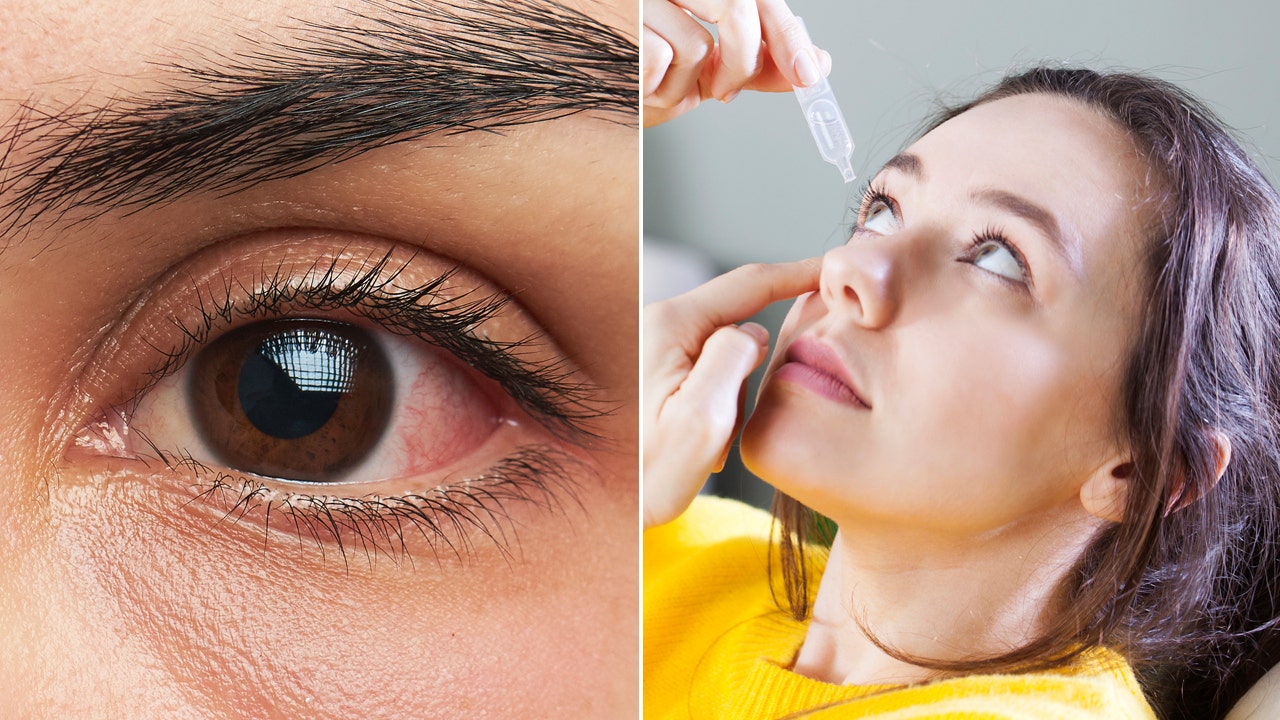Health
Be well: Treat and prevent pink eye with a health specialist’s top tips

Anyone who’s ever been plagued with pink eye — and its telltale signs of irritation, itchiness and discharge — likely will want to take measures to prevent it from happening again.
Also known as conjunctivitis, the infection causes the white of the eye to become pink or red, hence its more familiar name.
As many as six million children and adults contract pink eye each year, according to Cleveland Clinic.
To help you recognize the symptoms and prevent spreading, Dr. James Kelly, M.D., of the Kelly Vision Center in New York City, shared expert tips and insights with Fox News Digital.
POPULAR CONTACT LENSES COULD CONTAIN TOXIC ‘FOREVER CHEMICALS,’ NEW STUDY FINDS
“The three main types of pink eye are viral, allergic and bacterial in nature,” Kelly explained. “The most common cause is a virus known as adenovirus, although it may also be caused by certain types of bacteria and fungi.”
Molds, pollen and other allergens can also trigger the infection, Cleveland Clinic states on its website.
As many as six million children and adults contract pink eye each year, according to Cleveland Clinic. (iStock)
In some less common cases, pink eye can stem from a foreign object in the eye, external irritants, autoimmune diseases or blocked tear ducts, per Cleveland Clinic.
“It is more common in children and teens, especially during the summer, as they are in camps, day care or spending time together at pools,” Kelly said.
Watch for these symptoms
“Typical symptoms of pink eye include redness, swelling, tearing, discharge, crusting and burning,” Kelly told Fox News Digital.
Some people may also experience blurry vision, increased sensitivity to light and itchiness.
BE WELL: GET REGULAR EYE EXAMS TO PROTECT VISION AND CATCH WARNING SIGNS EARLY
“Most pink eye resolves without treatment or permanent damage, usually within a few days,” the doctor said. “For some, however, it may take two to three weeks to fully resolve.”
If left untreated, pink eye can sometimes result in permanent scar tissue, Kelly warned. To avoid this and to eliminate symptoms faster, he suggests seeking medical care.
Know the treatment of pink eye
Medicated eyedrops — specifically artificial tears and antibiotics — are the mainstay of treatment for pink eye, Kelly said.
“Occasionally, steroid eye drops are prescribed depending on the clinical features the individual may have upon presentation to the eye doctor,” he also said.

To avoid scar tissue and to eliminate symptoms faster, it’s best to seek medical care, an ophthalmologist said. (iStock)
Bacterial pink eye is treated with antibiotic eyedrops, pills or creams.
Pink eye caused by a virus doesn’t respond to antibiotics. Cases caused by allergies can be treated with over-the-counter or prescription eyedrops.
A health care provider can determine what type of conjunctivitis is causing the symptoms.
Prevent the spread
Pink eye is very contagious — it can easily be transmitted from person to person.
Proper hygiene is critical to preventing the spread and relapse of the infection, Kelly said.
Bacterial conjunctivitis is contagious from the point when symptoms appear until 24 to 48 hours after beginning antibiotics, according to Cleveland Clinic.
CLICK HERE TO SIGN UP FOR OUR HEALTH NEWSLETTER
Viral pink eye can be transmitted for the entire duration of symptoms, or even before they begin.
Pink eye that’s caused by allergies is not contagious.

Proper hand-washing is also very important in controlling the spread of pink eye, especially after applying eye drops or ointment. (iStock)
“Sharing personal items like pillowcases, towels and makeup can result in the spread of the underlying infectious cause, so it is strongly advisable not to do so,” Kelly said.
Viruses and bacteria can live on surfaces for hours to days, he warned, so it is best to limit contact with others while infected with pink eye.
Proper hand-washing is also very important in controlling spread, especially after applying eye drops or ointment.
“Certain people are more susceptible, especially those who are contact lens users or who have weakened immune systems,” Kelly said.
To read more pieces in Fox News Digital’s “Be Well” series, click here.

Health
Semaglutide Pills and Injections Vs. Drops: Experts Weigh In | Woman's World

Sign Up
Create a free account to access exclusive content, play games, solve puzzles, test your pop-culture knowledge and receive special offers.
Already have an account? Login
Use left and right arrow keys to navigate between menu items.
Use escape to exit the menu.
Health
Jennifer Hudson Lost 80-Lbs Without Depriving Herself—Learn Her Secrets

Sign Up
Create a free account to access exclusive content, play games, solve puzzles, test your pop-culture knowledge and receive special offers.
Already have an account? Login
Use left and right arrow keys to navigate between menu items.
Use escape to exit the menu.
Health
Kennedy’s Plan for the Drug Crisis: A Network of ‘Healing Farms’

Though Mr. Kennedy’s embrace of recovery farms may be novel, the concept stretches back almost a century. In 1935, the government opened the United States Narcotic Farm in Lexington, Ky., to research and treat addiction. Over the years, residents included Chet Baker and William S. Burroughs (who portrayed the institution in his novel, “Junkie: Confessions of an Unredeemed Drug Addict”). The program had high relapse rates and was tainted by drug experiments on human subjects. By 1975, as local treatment centers began to proliferate around the country, the program closed.
In America, therapeutic communities for addiction treatment became popular in the 1960s and ’70s. Some, like Synanon, became notorious for cultlike, abusive environments. There are now perhaps 3,000 worldwide, researchers estimate, including one that Mr. Kennedy has also praised — San Patrignano, an Italian program whose centerpiece is a highly regarded bakery, staffed by residents.
“If we do go down the road of large government-funded therapeutic communities, I’d want to see some oversight to ensure they live up to modern standards,” said Dr. Sabet, who is now president of the Foundation for Drug Policy Solutions. “We should get rid of the false dichotomy, too, between these approaches and medications, since we know they can work together for some people.”
Should Mr. Kennedy be confirmed, his authority to establish healing farms would be uncertain. Building federal treatment farms in “depressed rural areas,” as he said in his documentary, presumably on public land, would hit political and legal roadblocks. Fully legalizing and taxing cannabis to pay for the farms would require congressional action.
In the concluding moments of the documentary, Mr. Kennedy invoked Carl Jung, the Swiss psychiatrist whose views on spirituality influenced Alcoholics Anonymous. Dr. Jung, he said, felt that “people who believed in God got better faster and that their recovery was more durable and enduring than people who didn’t.”
-
/cdn.vox-cdn.com/uploads/chorus_asset/file/25822586/STK169_ZUCKERBERG_MAGA_STKS491_CVIRGINIA_A.jpg)
/cdn.vox-cdn.com/uploads/chorus_asset/file/25822586/STK169_ZUCKERBERG_MAGA_STKS491_CVIRGINIA_A.jpg) Technology1 week ago
Technology1 week agoMeta is highlighting a splintering global approach to online speech
-

 Science1 week ago
Science1 week agoMetro will offer free rides in L.A. through Sunday due to fires
-
/cdn.vox-cdn.com/uploads/chorus_asset/file/23935558/acastro_STK103__01.jpg)
/cdn.vox-cdn.com/uploads/chorus_asset/file/23935558/acastro_STK103__01.jpg) Technology1 week ago
Technology1 week agoAmazon Prime will shut down its clothing try-on program
-

 News1 week ago
News1 week agoMapping the Damage From the Palisades Fire
-
/cdn.vox-cdn.com/uploads/chorus_asset/file/25826211/lorealcellbioprint.jpg)
/cdn.vox-cdn.com/uploads/chorus_asset/file/25826211/lorealcellbioprint.jpg) Technology7 days ago
Technology7 days agoL’Oréal’s new skincare gadget told me I should try retinol
-
/cdn.vox-cdn.com/uploads/chorus_asset/file/25832751/2192581677.jpg)
/cdn.vox-cdn.com/uploads/chorus_asset/file/25832751/2192581677.jpg) Technology4 days ago
Technology4 days agoSuper Bowl LIX will stream for free on Tubi
-

 Business5 days ago
Business5 days agoWhy TikTok Users Are Downloading ‘Red Note,’ the Chinese App
-
/cdn.vox-cdn.com/uploads/chorus_asset/file/25835602/Switch_DonkeyKongCountryReturnsHD_scrn_19.png)
/cdn.vox-cdn.com/uploads/chorus_asset/file/25835602/Switch_DonkeyKongCountryReturnsHD_scrn_19.png) Technology2 days ago
Technology2 days agoNintendo omits original Donkey Kong Country Returns team from the remaster’s credits















